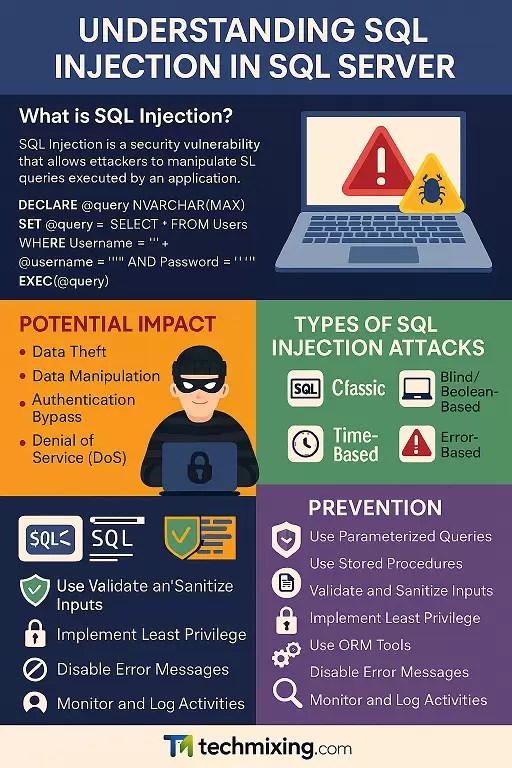Understanding SQL Injection in SQL Server

What is SQL Injection?
SQL Injection is a security vulnerability that allows attackers to manipulate SQL queries executed by an application. By injecting malicious SQL code, attackers can bypass authentication, access unauthorized data, modify or delete records, and even execute administrative operations on the database.
In SQL Server, like other database systems, SQL injection exploits improperly sanitized input fields. Dynamic SQL queries also pose a critical security risk.
How SQL Injection Works
Attackers exploit vulnerabilities in dynamic SQL queries that include user inputs. Consider the following example of a vulnerable query in SQL Server:
DECLARE @query NVARCHAR(MAX)
SET @query = 'SELECT * FROM Users WHERE Username = ''' + @username + ''' AND Password = ''' + @password + ''''
EXEC(@query)
If an attacker enters the following as input:
- Username:
' OR 1=1-- - Password:
anything
The query becomes:
SELECT * FROM Users WHERE Username = '' OR 1=1--' AND Password = 'anything'
OR 1=1: Always evaluates toTRUE.--: Comments out the rest of the SQL statement.
This query will return all rows in the Users table, bypassing authentication.
Potential Impact of SQL Injection
- Data Theft: Attackers can retrieve sensitive information like passwords, personal details, and financial data.
- Data Manipulation: Records can be inserted, updated, or deleted.
- Authentication Bypass: Allows attackers to log in as other users, including administrators.
- Denial of Service (DoS): Running malicious queries can exhaust server resources.
- Execution of System Commands: Advanced attacks may compromise the underlying system.
Types of SQL Injection Attacks
- Classic SQL Injection: Directly inject SQL commands into user inputs to manipulate queries.
- Blind SQL Injection: Exploits applications that do not return error messages but show changes in behavior or results.
- Boolean-Based Blind SQL Injection: Uses true/false conditions to infer data.
- Time-Based Blind SQL Injection: Executes time delays to measure response and infer information.
- Error-Based SQL Injection: Exploits error messages to gain insights into database structure.
Preventing SQL Injection in SQL Server
1. Use Parameterized Queries
Parameterized queries separate SQL code from data, preventing attackers from injecting malicious SQL. For example:
Vulnerable Query:
EXEC('SELECT * FROM Users WHERE Username = ''' + @username + ''' AND Password = ''' + @password + '''')
Safe Query:
DECLARE @query NVARCHAR(MAX)
SET @query = 'SELECT * FROM Users WHERE Username = @Username AND Password = @Password'
EXEC sp_executesql @query, N'@Username NVARCHAR(50), @Password NVARCHAR(50)', @Username, @Password
2. Use Stored Procedures
Stored procedures ensure input is treated as data, not executable code.
CREATE PROCEDURE GetUser
@Username NVARCHAR(50),
@Password NVARCHAR(50)
AS
BEGIN
SELECT * FROM Users WHERE Username = @Username AND Password = @Password
END
Execution:
EXEC GetUser @Username = 'Alice', @Password = '1234'
3. Validate and Sanitize Inputs
Ensure all user inputs conform to expected formats:
- Use whitelisting to allow only specific characters.
- Reject or escape special characters like
',--,;, etc.
4. Implement Least Privilege Principle
Restrict database user permissions to the minimum necessary:
- Use roles and restrict write/delete access for public-facing applications.
5. Use ORM Tools
Object-Relational Mapping (ORM) frameworks like Entity Framework or Hibernate abstract database interactions and automatically handle parameterization.
6. Disable Error Messages for Users
Do not expose detailed error messages to end-users as they can reveal database structure.
SET NOCOUNT ON
RAISERROR('An error occurred. Please try again later.', 16, 1)
7. Monitor and Log Database Activities
Enable SQL Server Audit and review logs for suspicious activities.
8. Use Web Application Firewalls (WAF)
WAFs can detect and block SQL injection attempts in HTTP requests.
Testing for SQL Injection Vulnerabilities
Use tools to test SQL injection vulnerabilities:
- Manual Testing: Inject payloads like
' OR 1=1--to observe responses. - Automated Tools: Use tools like SQLmap or Burp Suite.
Conclusion
SQL Injection is a serious threat to any application relying on SQL Server if not addressed properly. Adopting best practices like parameterized queries, input validation, and strict access control can mitigate risks effectively. Regular security audits and staying updated with the latest patches further strengthen defenses against SQL injection attacks.
Read more articles on Performance tuning, click here
Read more articles on SQL Server, click here
Read more articles on Azure, click here
Enjoyed this post? Support the blog by liking, sharing, and subscribing for more articles on Data, AI & Cloud.
Discover more from Technology with Vivek Johari
Subscribe to get the latest posts sent to your email.



